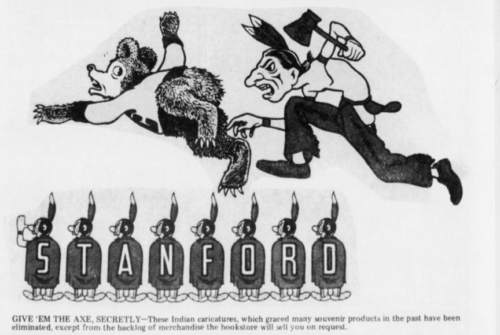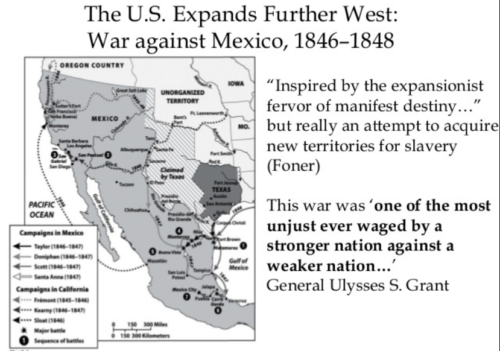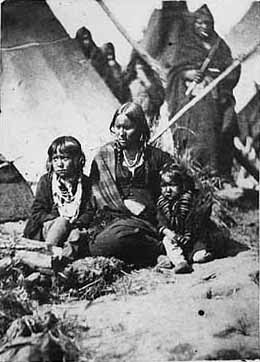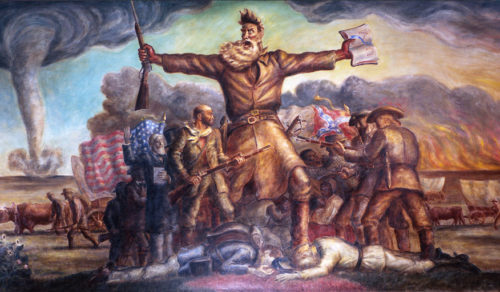A search on the Internet for “Stanford genocide” brings up a long list of references. Some initial hits are these, all very promising:
- Genocide: A World History – Stanford University
- Genocide | Center for Comparative Studies…
- Preventing Genocide | Stanford Libraries
However, as you scroll down the list, perhaps the most interesting hit of all is this one warning that Stanford should be known as a “primary architect of annihilation”:
“Naming America’s Own Genocide”
“Genocide” is a powerful word, but one whose impact has been diminished through overuse. Madley doesn’t use the word carelessly, even though he’s writing about US policy toward American Indians, a subject that often leads people to toss the term around quite loosely. His book does not contend, as more polemical works do, that all Indian policy was genocidal. He concentrates instead on a particular place and time: California from 1846 to 1873. […] Madley argues—and this is the core of his book—that California’s elected officials were in fact “the primary architects of annihilation,” and that they were funded and enabled by the federal government. Together, state and federal officials created what Madley describes as a “killing machine” composed of US soldiers, California militia and volunteers, and slavers and mercenaries (so-called “Indian hunters”) in it for the money.
Overall, it is clear that Stanford’s success was built on a system that was often exploitative and unjust, which benefited from extreme violence, repression, and genocide.
Stanford served in California state legislature as a Senator in the 1850s and oversaw Native American policy as a member of the Committee on Indian Affairs. That foreshadowed his governorship actions in 1862 to 1863, when he signed into law appropriations bills specifically meant to fund a “killing machine” that would wipe out Native American tribes in the state, a policy of forced removal of Native Americans from their ancestral lands.
Keep in mind at the point Stanford “oversaw” the fate of Native Americans, their population of approximately 310,000 just had been reduced to about 150,000 in the prior 77 years. Stanford’s push for a “killing machine” then totally decimated surviving populations, reducing them to just 12,000 people.
Stanford not only was head of government he was involved in business ventures that benefited from the displacement and exploitation of Native American communities, including the acquisition of land that had been taken from those communities through violent means.
Stanford University sits on ancestral land stolen from the Muwekma Ohlone Tribe.
Genocide.
The San Francisco Chronicle calls this “The moral case for renaming Hastings [and Stanford]“.
Leland Stanford solicited volunteers for his Civil War-era army campaigns against California Indians and, as governor, signed into law appropriations bills to fund those killing expeditions. He later founded Stanford University in the name of his son, Leland Stanford Jr. Both Hastings and Stanford had made fortunes in real estate. Their ability to acquire land titles was facilitated by the massacre of the rightful claimants, a near-extinction they promoted and funded. As UCLA professor Benjamin Madley wrote in his sobering “An American Genocide,” published in 2016 by none other than Yale University Press, both Stanford and Hastings had “helped to facilitate genocide.”
The California State Library puts it plainly:
California is birthed in genocide. […] As governor of California from 1861 to 1863, [Stanford] signs into law appropriation bills to finance those killing expeditions. Stanford’s favorite Indian killer is Major James D. Savage, leader of a militia called the “Mariposa Battalion.” Facilitated by the successes of extermination, both Hastings and Stanford acquire vast tracts of land and make fortunes in real estate. Their ability to acquire land titles is facilitated by their massacre of the rightful claimants.
Stanford wealth and assets came from massacres.
While all these references may seem to be ancient history, don’t forget Stanford recently hired Facebook’s disgraced head of security after he allegedly helped to facilitate genocide.
Change seems necessary and long overdue.
Is renaming from Stanford possible?
It appears to me this University moving to a better name is not out of the question.
We already know Stanford agreed to remove cartoonish and degrading “Indian” imagery as its mascot. If you read the fine print on the following example it says offensive memorabilia was declared eliminated by making it secret, meaning easily available from the bookstore on request.

In other words Stanford moves quickly when it wants to and uses creative solutions to deal with those uncomfortable with change/progress. The school offers an official timeline explaining how in just two years time they switched to being the Cardinals in 1972.
On November 22, 1970, Stanford American Indian Organization (SAIO) members petition for removal of Stanford’s Indian mascot—both the logo (as a “false image of the American Indian”) and the man, Timm Williams (whose live performances at sporting events were a “mockery of Indian religious practices.”) Native American students position themselves outside the Stanford Stadium at the Big Game against the University of California with banners saying “Indians are people, not mascots.”
SAIO members retell the story a little more broadly. They point out Governor Ronald Reagan’s “Indian staff person” is who voluntarily dressed and danced as a human mascot, and was breaking a promise he made to cease derogatory and demeaning acts:
The big issue with Timm Williams was his mockery of Indian religions. He would dance around in a faux Indian dance at the games. Even though he was a Yurok Indian, he wore the recognizable Plains Indian headdress and clothes to every game. He would make the “woo woo” sound with his hand slapping his mouth. We met with him a month after we got there, and he promised not to do it anymore. Shortly afterward he became the Indian staff person to Gov. Ronald Reagan, who infamously did nothing to understand Indians, most of whom had lost their Indian status when their treaties were terminated in the 1950s. But Timm did it again the next week. That was it for us. The Indian symbol, the caricatured Indians with the big noses, the religious denigration—all of it had to go. It took two years, but we finally got it done.
Governor Reagan fired Williams just months after Stanford changed its mascot.
Outside pressure clearly has worked on Stanford. Also, inside pressure has shown to be effective, as explained by members of the Stanford marching band who transformed it into a protest against a history of exterminating native cultures.
Part of assimilating Indigenous children in boarding schools into American society was handing them European music instruments to play European music. The government thought it would assist with wiping away their traditional musical practices. Marching bands came into play. […] “When it comes to discipline, the Stanford band is zero discipline,” said the Miwok citizen with a laugh and an emphasis on zero. The university’s marching band is “pretty nontraditional. Technically, we’re a scatter band,” Brown said. So they don’t actually march. They run from one formation to the other. What else makes the band nontraditional? No experience is required. It’s zero commitment meaning they welcome beginners to advanced musicians. This can also be current students, alumni or community members. Members hardly wear bucket hats and military-style uniforms. If they do, they can customize it with buttons and pins. Other university bands, like the University of Southern California, hate them. People yell at them and get upset because they’re not traditional.
I write this all in response to those who have asked me what to do after they read history of America and its episodes of genocide, a history that quite frankly historians tend to point out Nazi Germany studied for inspiration.
Let me put it this way. If Germans asked what to do about a university named for someone who committed genocide, what would any American probably tell them to do? Renaming should be an obvious answer here, though Americans seem not to welcome the very step that they enforced on Germany during occupation.

Other states already have figured out how to turn the corner. Take for example Minnesota’s Governor who very clearly came forward and condemned a past Minnesota Governor known for saying the U.S. should exterminate Native Americans.
“I am appalled by Governor Ramsey’s words and by his encouragement of vigilante violence against innocent people; and I repudiate them,” Gov. Mark Dayton said in a statement released Thursday. “The viciousness and violence, which were commonplace 150 years ago in Minnesota, are not accepted or allowed now.” Dayton called for flags to fly at half-staff from sunrise to sunset Friday, declaring it a day of remembrance and reconciliation on the 150th anniversary of the start of the six-week U.S.-Dakota War of 1862. He asked Minnesotans “to remember that dark past; to recognize its continuing harm in the present; and to resolve that we will not let it poison the future.”
We have yet to see California leaders take even basic steps to call out Governor Stanford for who he was and what the Stanford name means to this day — resolve to stop letting it poison the future by demanding change in the present.
In case that reference to Stanford isn’t clear, his gubernatorial candidate acceptance speech of 1859 allegedly was “I prefer free white citizens to any other race”. Then, after becoming Governor of California, in his first speech he wrote clearly white supremacist life goals straight into the official record books:
There can be no doubt but that the presence of numbers among us of a degraded and distinct people must exercise a deleterious influence upon the superior race, and, to a certain extent, repel desirable immigration.
Racial purity? As Stanford’s basis for genocide and internment camps?
Go ahead and tell me how this is any different from someone following Hitler’s orders.
Stanford is an important domino towards addressing wider American systemic racism.
Of course some warn it won’t be easy erasing this genocidal xenophobic white supremacist’s name, while they also ironically point out how Stanford already has been renaming things (again thanks to outside pressures).
California has a racist past. But removing monuments sparks debate about how to reflect an ugly history…Stanford University last month decided to rename three campus references to Father Junipero Serra, who founded the California mission system in the 1700s and whose legacy came under fire for the missions’ treatment of Native Americans.
I’m not saying by any means that Stanford was the only bad guy to focus on, and thus also agree with removing Serra (Stanford has very shamelessly replaced Serra with… Stanford).
What I’m saying is that even Stanford admits there is an important point to renaming anything that reflects “ugly” treatment of Native Americans.
Stafford Poole, the renowned historian on colonial Latin America, explains at a macro level how Stanford really was a powerful cog in a wider context of U.S. creating California to exterminate Native Americans.
The true villain is James K. Polk, the [1845 to 1849] president who maneuvered the country into an immoral war for which he was opposed by a congressman named Abraham Lincoln.
For those unfamiliar with the Bay Area, Polk tends to be a popular and significant street name.
Poole is of course not only right, his point should be taken to mean the U.S. President Polk who in 1846 invaded Mexi-Cali to eradicate people living there and replace with white settlers…also probably shouldn’t have his name on anything today.

Note that quote from Grant, a true American hero in every sense. If you want to celebrate someone in American history, he’s the real deal.
Stanford stands out as the most significant target for renaming due to the heavy and widespread use as an honorific badge among scholars — influence is an understatement — not to mention the University obviously has aspirations to prevent further genocide (see initial links at the top of this blog).
When Stanford finally renames it likely will have influence on others to follow.
After Stanford in 1972 dropped their “Indian” mascot Dartmouth did the same.
I imagine after Stanford gets a better name someone will petition for places like San Francisco’s rather obscure yet busy Polk Street to be renamed (take note how “Polk Gulch” bloggers chastise other place names while apparently ignoring their own name).
The SAIO proved to the world in 1970 that Stanford University is capable of change, even rapidly evolving away from its ugly past.
We’re long past time to course correct the shameful “Stanford asshole” trend. Renaming Stanford to something not so “ugly” would be more than a symbolic way to help.
I propose Ohlone be consulted for the new name. Let them decide what the their land should be called.
And in the meantime go ask anyone brandishing the genocidal Stanford name to explain why they promote his crimes against humanity.
Oh, and also perhaps also ask why Mrs. Stanford was murdered with poison yet school officials refused to admit the facts, instead trying to claim she died from having too nice a lunch.


